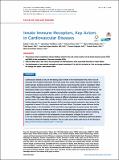Por favor, use este identificador para citar o enlazar a este item:
http://hdl.handle.net/10261/222223COMPARTIR / EXPORTAR:
 SHARE SHARE
 CORE
BASE CORE
BASE
|
|
| Visualizar otros formatos: MARC | Dublin Core | RDF | ORE | MODS | METS | DIDL | DATACITE | |

| Título: | Innate immune receptors, key actors in cardiovascular diseases |
Autor: | Jaén, Rafael I. CSIC ORCID; Val-Blasco, Almudena; Prieto, Patricia CSIC ORCID; Gil-Fernández, Marta CSIC; Smani, Tarik CSIC ORCID; López-Sendón, José Luis; Delgado, Carmen CSIC ORCID ; Boscá, Lisardo CSIC ORCID CVN ; Fernández-Velasco, María CSIC ORCID | Palabras clave: | Cardiovascular diseases Innate immune system NLRP3 NOD1 Nucleotide-binding oligomerization domain-like receptors Toll-like receptors |
Fecha de publicación: | 2020 | Editor: | Elsevier | Citación: | JACC: Basic to Translational Science 5(7): 735-749 (2020) | Resumen: | Cardiovascular diseases (CVDs) are the leading cause of death in the industrialized world. Most CVDs are associated with increased inflammation that arises mainly from innate immune system activation related to cardiac damage. Sustained activation of the innate immune system frequently results in maladaptive inflammatory responses that promote cardiovascular dysfunction and remodeling. Much research has focused on determining whether some mediators of the innate immune system are potential targets for CVD therapy. The innate immune system has specific receptors—termed pattern recognition receptors (PRRs)—that not only recognize pathogen-associated molecular patterns, but also sense danger-associated molecular signals. Activation of PRRs triggers the inflammatory response in different physiological systems, including the cardiovascular system. The classic PRRs, toll-like receptors (TLRs), and the more recently discovered nucleotide-binding oligomerization domain-like receptors (NLRs), have been recently proposed as key partners in the progression of several CVDs (e.g., atherosclerosis and heart failure). The present review discusses the key findings related to the involvement of TLRs and NLRs in the progression of several vascular and cardiac diseases, with a focus on whether some NLR subtypes (nucleotide-binding oligomerization domain, leucine rich repeat and pyrin domain-containing receptor 3 and nucleotide-binding oligomerization domain-containing protein 1) can be candidates for the development of new therapeutic strategies for several CVDs. | Versión del editor: | https://doi.org/10.1016/j.jacbts.2020.03.015 | URI: | http://hdl.handle.net/10261/222223 | DOI: | 10.1016/j.jacbts.2020.03.015 | ISSN: | 0735-1097 |
| Aparece en las colecciones: | (IIBM) Artículos (IBIS) Artículos |
Ficheros en este ítem:
| Fichero | Descripción | Tamaño | Formato | |
|---|---|---|---|---|
| innatdiseas.pdf | 3,04 MB | Adobe PDF |  Visualizar/Abrir |
CORE Recommender
PubMed Central
Citations
29
checked on 10-abr-2024
SCOPUSTM
Citations
50
checked on 23-abr-2024
WEB OF SCIENCETM
Citations
46
checked on 29-feb-2024
Page view(s)
140
checked on 23-abr-2024
Download(s)
249
checked on 23-abr-2024

